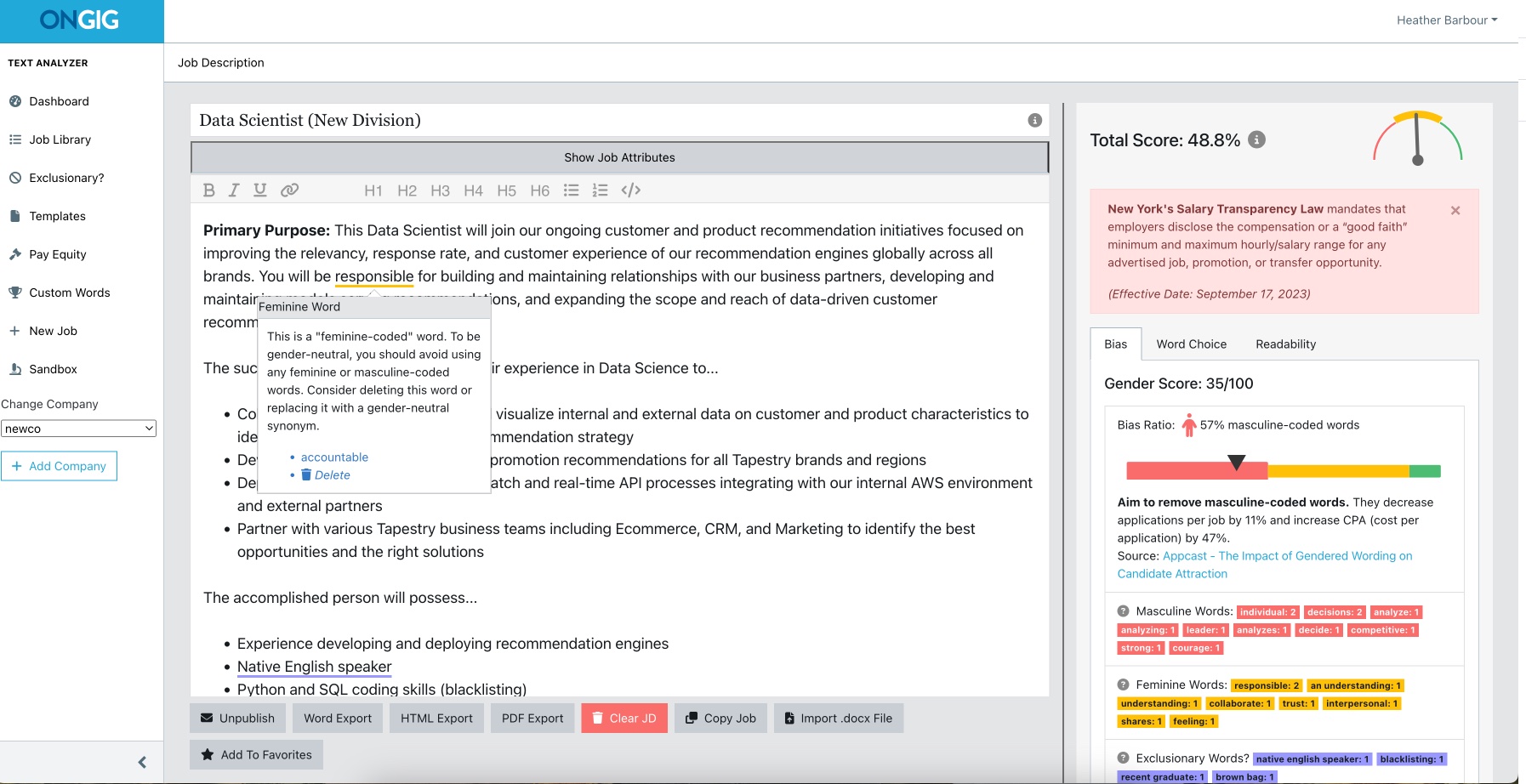- What’s the Difference Between a Job Description, Job Posting, and Job Ad - June 5, 2025
- Top 20+ Diversity Equity Inclusion Titles (with Descriptions) 2024 - October 18, 2024
- A List of Common Offensive (Exclusionary) Words Used in Job Descriptions (2024) - October 18, 2024
Masculine vs. feminine job descriptions remains a hot topic these days.
Last week I shared The Top 10 Masculine Biased Words Used in Job Descriptions. If you’re trying to gender-neutralize your job ads, eliminating those top 10 masculine-biased words is a good start.
So, are there loads of feminine-biased words in job ads?
Some of you then asked:
“What about feminine words — which words in job postings are biased towards attracting women.”
I used Ongig’s Text Analyzer software (the tool for gender bias in job descriptions) to find out.
I had Text Analyzer review 48,246 random job descriptions from U.S.-based companies of all sizes.
Note: Text Analyzer has a proprietary vocabulary library culled from social science and artificial intelligence research that flags masculine and feminine words like those shown below.
Here’s an example of a job description analyzed by Text Analyzer.

Below is the list of the top 10 feminine words that Text Analyzer has found in job descriptions:
Top 10 Feminine Words Used in Job Descriptions (2019)
- support
- share
- responsible
- understand (or understanding)
- together
- committed
- interpersonal
- feel
- collaborate (or collaboration)
- connect
If you want to attract more women, using words like the 10 above in your job postings is a good start. You might combine that move with eliminating most or all of the masculine words I wrote about in The Top 10 Masculine Biased Words Used in Job Descriptions.
For more tips on writing job descriptions, check out our How to Write a Job Description — Best Practices & Examples.
Top 10 Feminine-Coded Words Used in Job Postings [2024 Update]
Things change, including the words we use. So we decided to do another review (this time with 1 million+ job postings) to find the 10 most used words with male bias in the last 12 months. We also added some gender neutral alternatives you might find work well in your job postings. Here’s the lineup:
- responsible (accountable)
- support (help)
- understanding (knowledge, expertise)
- collaborate(s) (combine(s), join(s), unite(s), partner(s))
- collaboration (partnership)
- interpersonal (mutual, reciprocal, relational, social, face-to-face)
- understand (know, know about, reason)
- supports (helps)
- supporting (helping)
- collaborative (collective, combined, common)
You’ll notice some of the same “feminine wording” made the list again. Plus there are a few new female coded word choices in the lineup.
We chose gender-coded words (specifically female-coded for this blog) based on The Journal of Personality and Social Psychology which published a research study called Evidence That Gendered Wording in Job Advertisements Exists and Sustains Gender Inequality by Danielle Gaucher, Justin Friesen, and Aaron C. Kay — Duke University and University of Waterloo study). Kat Matfield also used this study to create a free tool, Gender Decoder, for words based on a specific gender (aka gender-biased language).
In late 2022, Ongig partnered with a global employment website to conduct new research around gendered language (and other biased words)…and the effect they have on application rates. The study revealed Ongig’s scoring is predictive of higher application rates across industries. Total apply starts increased by 13% and apply starts from female applicants boosted by 21%. This study proved the use of gender-sensitive language can help increase applies.
And, in a pilot of Ongig’s Text Analyzer one firm wanted to take on gender imbalance in traditionally male-dominated industries like engineering and finance. After updating the use of gender-biased words in their job ads, they saw a 22% increase in female applicants.
Note: We also did a breakdown of the 10 most used masculine-coded words if you want to see common words you can remove to create more gender neutral job ads.
And, here’s a list of 25 of the most-used exclusionary words. Check these out if you want more inclusive swaps when creating job posts during your hiring process. They include acceptable replacements for non-binary people, people with disabilities, people of color, and many other underrepresented groups.
Why I wrote this?
Ongig is on a mission to transform job descriptions. Ongig’s Text Analyzer eliminates gender bias, other biases and, overall, makes your job ads more attractive. If you’re hiring 100+ people per year, we’re happy to show you how to gender-neutralize your job descriptions. Just click the demo request button on this page or email us at friends@ongig.com. Thanks!
